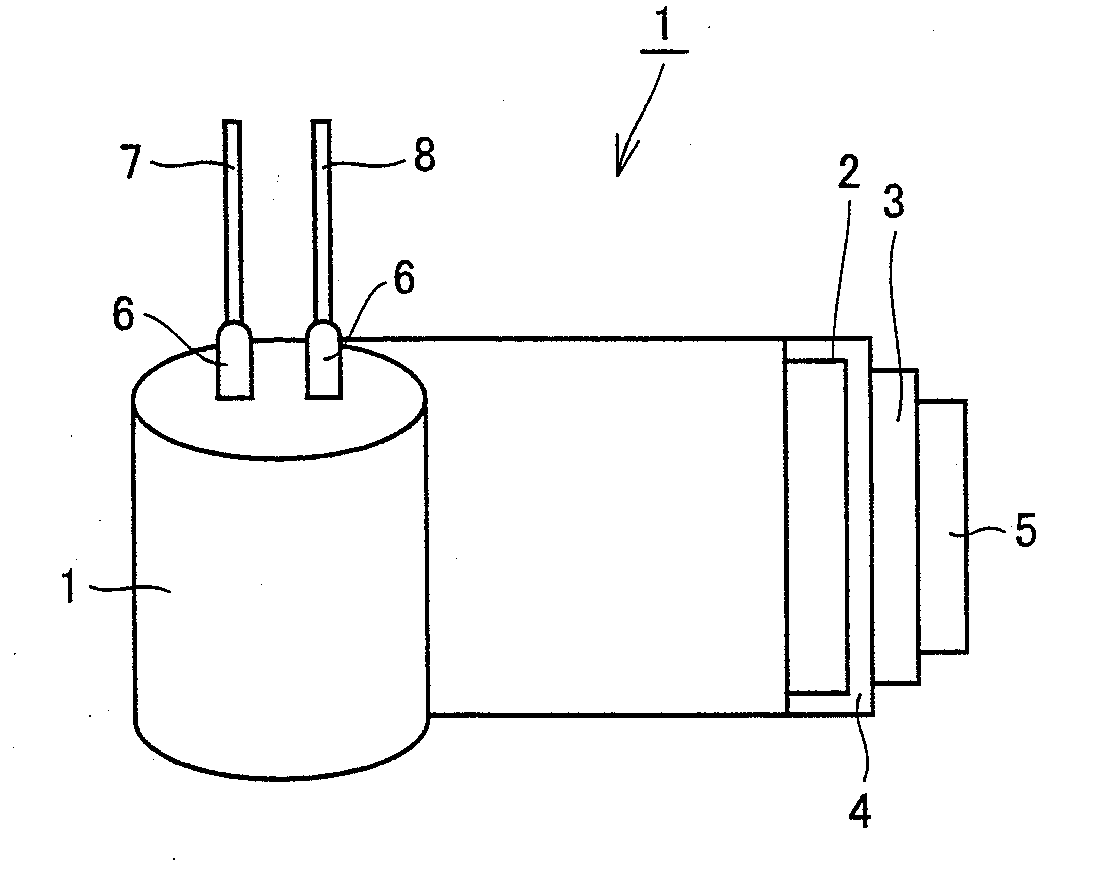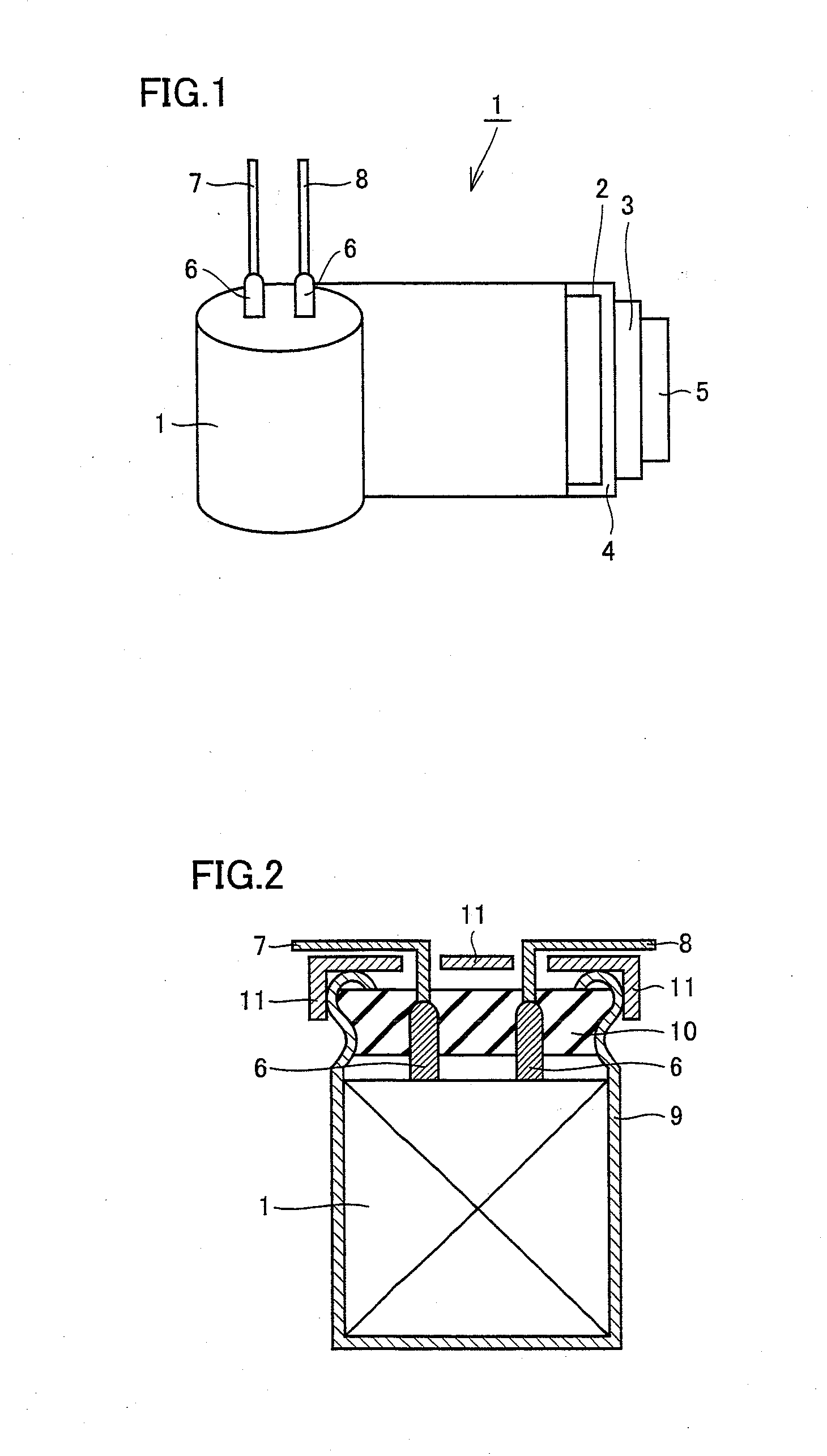Solid electrolytic capacitor and method of manufacturing the same
a solid electrolytic capacitor and solid electrolytic technology, which is applied in the manufacture of electrolytic capacitors, electrolytic capacitors, coatings, etc., can solve the problems of deteriorating the dielectric coating film on the anode foil, the difficulty of evenly and sufficiently impregnating the winding-type capacitor element with a conductive polymer, and the electric properties of the polyethylenedioxythiophene made by polymerizing dioxythiophene. achieve high reliability
- Summary
- Abstract
- Description
- Claims
- Application Information
AI Technical Summary
Benefits of technology
Problems solved by technology
Method used
Image
Examples
example 1
[0058]A description will be given with reference to FIGS. 1 and 2.
[0059]Firstly, a metal foil was subjected to etching treatment, chemical conversion treatment, and the like using known methods to prepare anode foil 2 as an anode having a dielectric coating film on a surface thereof. Then, anode lead 7 was attached to anode foil 2 through lead tab terminal 6. Next, cathode lead 8 was attached to cathode foil 3 through lead tab terminal 6. Subsequently, anode foil 2 and cathode foil 3 were wound with separator sheet 4 made of synthetic cellulose fiber being interposed therebetWeen, and secured with winding stop tape 5. Thereby, a wound portion as a basic structure of a winding-type capacitor element was formed. Thereafter, the wound portion was subjected to chemical conversion treatment of a cut section and heat treatment at 280° C.
>
[0060]A dopant and oxidant solution containing a chelating agent, a cyclic siloxane, and a sulfonic acid metal salt was prepared. As the chelating agent,...
examples 2 to 9
[0067]As the materials such as the chelating agent and the cyclic siloxane used to prepare respective dopant and oxidant solutions, the same materials as those used in Example 1 were selected, and respective solid electrolytic capacitors were manufactured by the same method as in Example 1 except for preparing the respective dopant and oxidant solutions in mixing ratios indicated in Table 1.
examples 10 to 12
[0077]Respective solid electrolytic capacitors were manufactured by the same method as in Example 3 except for changing the concentration of para toluene sulfonic acid in the cleaning liquid used for cleaning the anode in Example 3 to those indicated in Table 2.
TABLE 2Concentration in Dopant andAfter Reflow TestOxidant SolutionConcentration ofInitialInitialNumber of OccurrenceChelatingCyclic SiloxaneAromatic Sulfonic Acid inCapacitanceESRΔC / Cof Short CircuitAgent (wt %)(wt %)Cleaning Liquid (wt %)(μF)(mΩ)(%)ΔESR / ESRFailure (number)Example 100.5100.515024.3−4.41.100 / 30Example 3215223.2−2.31.010 / 30Example 11315024.5−3.31.040 / 30Example 12514825.9−3.41.084 / 30Comparative010214435.0−5.21.663 / 30Example 3
[0078]The solid electrolytic capacitors in accordance with Examples 10 to 12 were also examined as in the solid electrolytic capacitors in accordance with Examples 1 to 9. As can be seen from Table 2, the number of occurrence of a short circuit failure was reduced when the aromatic sulfonic...
PUM
 Login to View More
Login to View More Abstract
Description
Claims
Application Information
 Login to View More
Login to View More - R&D
- Intellectual Property
- Life Sciences
- Materials
- Tech Scout
- Unparalleled Data Quality
- Higher Quality Content
- 60% Fewer Hallucinations
Browse by: Latest US Patents, China's latest patents, Technical Efficacy Thesaurus, Application Domain, Technology Topic, Popular Technical Reports.
© 2025 PatSnap. All rights reserved.Legal|Privacy policy|Modern Slavery Act Transparency Statement|Sitemap|About US| Contact US: help@patsnap.com


